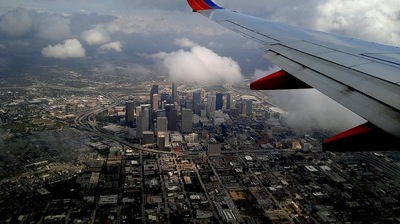
- 2 Mama Ninfa Legacies To Anchor Walkable District of Shops, Restaurants on Navigation Between Delano, St. Charles [Houston Chronicle]
- League City Breaks Ground on $31M Public Safety Building [Galveston County Daily News]
- Kemah To Consider $12M Park-and-Ride, Parking Facility [Galveston County Daily News]
- City Exploring Managed Paid Parking System Along Washington Ave. To Prevent Strip from Becoming Next Richmond Ave. [The Leader; proposal]
- School Bus, Trucks Seen Crossing Yale St. Bridge Illegally After Load Limit Lowered [KHOU]
- Most Voters Still Not Sure What Metro Referendum Actually Does; 1 in 4 Undecided, Finds Poll [KHOU]
- More Smelly Dead Fish Likely To Surface on Lake Madeline [Houston Chronicle]
- Bats Keep Visiting Woman’s Apartment at Lakeside Place Complex in Southwest Houston [Click2Houston]
- Texas City Suit Claims Man Swindled Woman Out of $200,000 in House-Flipping Scheme [Hair Balls]
- Investigating Houston’s Haunted Houses, Buildings [Click2Houston]
Photo: elnina999 via Swamplot Flickr Pool





I wont drive on the Yale bridge after having first hand experience of being trapped in my car in a body of water. Sh*#t happens – I was in my parked car, got rear-ended pushed through iron fencing and landscaping into a swimming pool. Luckily his car was front wheel drive and didnt land on top of mine!Next subject is Senior Drivers……
It’s worth re-iterating the point from the article; heavy trucks crossing the bridge won’t cause it to suddenly collapse, but will shorten its life even further.
Disclaimer: “won’t collapse” means very, very high probability that it won’t collapse. I Am An Engineer.
Anytime an engineer tells me “trust me, I am an engineer”, I run away in panic.
Anyhow, personally I enjoyed the concluding line in the Yale Street article highlighting the fact that buses, trucks and heavy vehicles frequently violate the load limits: “A Houston public works spokesman said load limits on the bridge exist to extend its life. He also said there is no cause for alarm as long as drivers follow the rules.” Guess what? People are not following the rules. I assume then, that contrary to what our engineer friend says above (“trust me, I am an engineer”), we should be alarmed.
No one from the City has ever been able to say that the bridge is safe even if the load limits are violated. I understand that load limits are intended to extend the life of a bridge and do not indicate that an overloaded vehicle will cause the bridge to come crashing down. The problem is that this bridge is at the end of its life. You cannot have a bridge with a load limitation of lower than 3000 lbs. The bridge has to be closed at that point because the risk of catastrophic failure becomes unacceptable. So, we are left to hope that the engineers catch the degradation in time to close the bridge before something awful happens. It take a lot of balls for an engineer to tell a municipality that they have to close a bridge.
@mel: Even when the engineer asserts that there is no such thing as 100% certainty? :)
@Old School: the engineer that performs the study will make his assessment and state his conclusions, with his PE license at stake. It’s up to the authority to take appropriate action.
What would happen if the city were to simply declare the bridge unsafe and close it, traffic flows be damned? Would that perhaps spur some form of emergency funding for construction of a replacement?
Simple solution: install a scale on bridge entrance. One under road that you drive over and works real time. If you’re over weight, a camera is triggered and snaps your plate. You get mailed a fine. Money is used to repair bridge when necessary.
.
(Scales cost $, but so does building and fixing a bridge, and the collection from violators should pay the cost back if its truly a problem)
Cody,
You are proposing what is essentially a redlight camera for load violators. We need to put in place a $1,000.00 fine for violators or close the bridge until it is repaired.
A ‘red light camera’ with a hefty fine would be an ideal target for the Kuboshes. They could defend our right to sink.